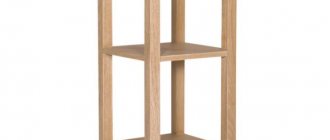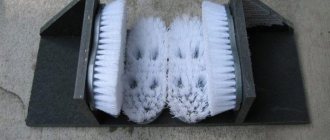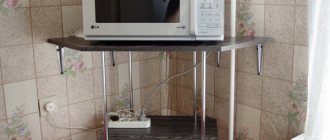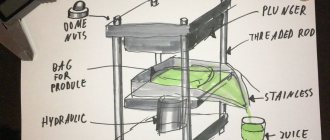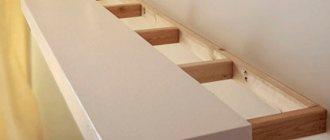My house is full of shoes. There is so much of it that you could write poems about it... For several years I have been thinking about how to make a shoe rack myself from cardboard tubes. It's time to bring it to life.
There are descriptions of similar DIY shoe racks online, so I decided to make my own based on them. The project is quite quick and if you have a basic set of tools, you can easily repeat it.
Coat hanger made of PVC pipes
In order to assemble such a simple structure from plastic pipes, you will need to prepare the following:
- Plastic pipe 2.5 meters long. The base of the entire structure will be made from it. The diameter of the pipes should be 2-2.5 centimeters. You can buy 200 centimeters of thick pipe and 50 centimeters of thinner pipe, which will give the finished structure an interesting look. Such pipes can be connected using adapters of suitable size.
- Bends with an even angle, the size of which must match the pipes.
- Connecting crosses needed to secure additional branches.
- Plastic pipe ends that are installed at the end, upon completion of the frame assembly.
- The cap needed for the top of the product.
- Soft fabric. If desired, it can be installed on the legs of the hanger so as not to damage the floor covering.
- Spray paint (any color). Of course, the product can be left snow-white, but some craftsmen prefer to paint the finished hanger structure.
- Scotch tape or glue. If you choose the first option, the structure will be less durable, but collapsible.
You can purchase colored pipes to skip the dyeing process
Important! During the work you will not need any specialized tools; you can get by with a regular hacksaw. In addition, coarse sandpaper is needed to sand the cuts.
The process of making a hanger
Table 3. Instructions for making a hanger from plastic pipes
| Illustration, step | Description |
Step one: cutting the pipes | First you need to prepare a convenient place for cutting pipes, and then make the following markings of the parts:
|
Step two: collecting the crosspiece parts | Two fragments 120 millimeters long must be inserted into one crosspiece for connection (into the holes on both sides). For greater reliability, the edges of the pipes must be treated with glue or wrapped with adhesive tape. Next, you need to make three more connections in the same way. |
Step Three: Connecting the Base | Then you will need to connect these fragments to get a hanger rack. To do this, two connections are placed in one row, and another one is installed in the middle, as shown in the photo. |
Step four: collecting the legs | Next, you need to make stable legs for the hanger. Round bends are installed on each side of the pipes, then caps are attached to them and pieces of soft fabric are glued exactly to size (so that the hanger does not scratch the floor). |
Step Five: Adjusting the Base | Then the legs must be turned in the desired direction. In addition, you should trim the part that is in the middle and, if necessary, expand it, which will allow you to get a finished rack. |
Step Six: Installing the Center Piece | The longest fragment (800 millimeters) must be connected to the central piece to form a leg for additional branches. |
Step seven: connecting the hanger | Then you will need to put the prepared cross onto the central pipe. It is worth noting that one of its openings should look down and the other should look up. |
Step eight: connecting the branch | A piece of pipe 150 millimeters long should be attached to the hole on the side, and a rounded outlet should be fixed to it (end up), then closed with a plug. If you wish, you can not add this corner. |
Step Nine: Adjusting the Hanger | Next, you need to expand the branches to the sides - this will allow you to better distribute the total load on the frame. In addition, this arrangement gives the hanger a complete, aesthetic look. |
Step ten: installing plugs | It is necessary to attach the last fragment 100 millimeters long to the top of the pipe, and then put a cap on it. |
Step Eleven: Painting | At this stage, the structure is considered ready, but if desired, it can be painted in any color using special paint. Here you can use your imagination and paint the product with various patterns. You can stick strips of tape on the hanger, paint it, and remove them after drying. |
The only disadvantage of this design is poor stability, so if the hanger is not supposed to be disassembled, then you can pour sand into the pipes at the assembly stage, so that it will not fall under the load of clothes.
Video - Floor hanger made of pipes
Let's sum it up
There are a huge number of different unusual ideas for making hangers from PVC pipes. The main advantage is that such a lightweight material is quite easy to work with, so both men and women can handle the assembly process without special physical training. Working with pipes is simple and allows you to use your imagination, because you can not just follow the assembly instructions, but at your own discretion modify the above methods, thereby creating unique designs.
Any apartment begins with a corridor or hallway, and these rooms leave the first impression of the entire housing, and it is this that is often the most objective. How to make a clothes hanger in the corridor with your own hands? Read in the special article.
Installation of shoe boots
Now we will need to install the mechanisms for the shoe rack. They are attached to the sides. Below are the installation dimensions and mounting drawings of these mechanisms:
To make it easier to figure out the installation dimensions and easier to install the opening mechanism for our shoe rack, you can use the drawings below.
On the sidewalls you need to mark the attachment points for the rotation axis and the stop pin, and you can immediately screw the panels to the sidewalls.
Our shoe shoe has a standard size: 192*287*85*16 . First, make markings for future fastening of the plastic part according to the above drawing and installation diagram (for each shoe shoe, the kit always includes a drawing and a wiring diagram for its installation, according to which, in fact, the installation should be carried out).
First of all, the shoe shoe needs to be screwed to the sidewalls of the chipboard using self-tapping screws. In this case, pay attention to the fact that the shoe shoe should tilt freely and return to its original position.
Now you need to connect the parts made of chipboard (the shoe shoe itself), the thickness of which is 10 mm, and the plastic parts of the shoe shoe.
Do this in stages. That is, first you insert the parts into special grooves and screw them with self-tapping screws to the left side panel, then to the internal vertical partition. After that, repeat these steps with the back of the partition and the right side.
At the next stage, all we have to do is install the facades, handles and thrust bearings.
For more precise installation of facades, you can use double-sided tape. Those. The fronts here can be installed in the same way as on a regular drawer.
We glue double-sided tape onto the shoe shoe, try on the facade, press it and screw it.
Please note: in our detailing, the dimensions of the facades for cutting and edging are already indicated with the necessary indents and gaps of 2 mm on each side. Also, based on the installation drawing of the shoe shoe, the gap of the facade from below should be at least 7 mm!!!
That is, step by step, we have:
- The height of the opening for the facade is 326 mm.,
- height of the facade in detail 311 mm.,
- when we glue the edge to the facade, we will add 2 mm on each side - it will already be 315 mm,
- you will also need 2 mm for the gap,
- As a result, in an opening with a height of 326 mm there will be a facade with a height of 315 mm (2 mm each for the gap at the top and bottom, plus an additional gap of 7 mm at the bottom).
Next, mark the holes for the handles and screw them on.
At the very end, all we have to do is screw on the thrust bearings and at this point the assembly can be considered complete.
